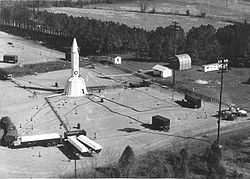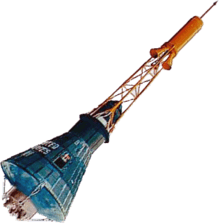PGM-19 Jupiter
| SM-78/PGM-19 Jupiter | |
|---|---|
|
Jupiter missile emplacement showing ground support equipment. The bottom third of the missile is encased in a "flower petal shelter" of wedge-shaped metal panels allowing crews to service the missile in all weather conditions. | |
| Type | Medium-range ballistic missile (MRBM) |
| Place of origin | United States |
| Service history | |
| Used by |
United States Air Force Italian Air Force Turkish Air Force |
| Production history | |
| Designed | 1954 |
| Manufacturer | Chrysler |
| Produced | 1956–1961 |
| Number built | ≈100 (45 deployed) |
| Variants | Juno II |
| Specifications | |
| Weight | 49,800 kg (110,000 lb) |
| Length | 18.3 m (60 ft) |
| Diameter | 2.67 m (8 ft 9 in) |
|
| |
| Propellant | kerosene and liquid oxygen |
Operational range | 1,500 mi (2,400 km) |
| Flight ceiling | 610 km (380 mi) |
The PGM-19 Jupiter was the first medium-range ballistic missile (MRBM) of the United States Air Force (USAF). It was a liquid-propellant rocket using RP-1 fuel and LOX oxidizer, with a single Rocketdyne LR70-NA (model S-3D) rocket engine producing 667 kN of thrust. The prime contractor was the Chrysler Corporation.
The missiles, armed with nuclear warheads, were deployed in Italy and Turkey in 1961 as part of NATO's Cold War deterrent against the Soviet Union. They were all removed by the United States as part of a secret agreement with the Soviet Union during the Cuban Missile Crisis.
History
Development and testing
In September 1955, Wernher von Braun, briefing the U.S. secretary of defense on long range missiles, pointed out that a 1,500 mi (2,400 km) missile was a logical extension of the PGM-11 Redstone. Accordingly, in December 1955, the secretaries of the Army and Navy announced a dual Army–Navy program to create a land- and sea-based MRBM.
The requirement for shipboard storage and launching dictated the size and shape of the Jupiter, which emerged as a short squat missile with a large girth. Although the Navy disliked the Jupiter's cryogenic propellants and dropped it during 1956 in favor of the solid-fueled UGM-27 Polaris submarine-launched ballistic missile, Jupiter retained its shape, making it too big for carriage in contemporary cargo aircraft such as the Douglas C-124 Globemaster II.
In November 1956, the Department of Defense assigned all land-based long-range missiles to the Air Force, with the army retaining control of battlefield missiles with a range of 200 miles (320 km) or less. The Jupiter MRBM program was transferred to the Air Force, which had developed the PGM-17 Thor MRBM independently, and was not altogether happy with the Jupiter program.
Jupiter test flights officially commenced with the launch of Missile 1A on March 1, 1957 from Cape Canaveral's LC-5. The vehicle performed well until past 50 seconds into launch when control started to fail, leading to breakup at T+73 seconds. It was deduced that overheating in the boattail had burned through the wiring, thus extra insulation was added there on future flights. On April 26, Missile 1B was launched, but broke apart at T+93 seconds from propellant slosh, leading to the addition of baffles to the fuel tanks. The third test on May 31 succeeded, as did launches on August 28 and October 23. Test number six on November 27 failed due to a turbopump malfunction at T+202 seconds and so did the next launch on December 19, causing the missile to lose thrust at T+116 seconds and fall into the Atlantic Ocean. On January 15, 1958, Jupiter was declared operational.
The turbopump problems on Missiles AM-3A and AM-4 were due to an inadequate design that resulted in a string of failures in the Jupiter, Thor, and Atlas programs, all of which used a variant of the same Rocketdyne engine. Rocketdyne came up with a number of fixes and the Army retrofitted all its Jupiters with the redesigned pumps, thus there were no more Jupiter failures caused by turbopumps. The Air Force by comparison was reluctant to fix their Thor and Atlas missiles if it meant delaying the program and so had several more turbopump-related launch failures during 1958.
The first three tests of 1958 were all successful and concentrated on detaching and recovering dummy reentry vehicles. Missile AM-19 (October 10) went out of control and was destroyed at T+49 seconds due to a fire in the boattail section. Afterwards, there was only one more failure in the Jupiter program, AM-23 on September 15, 1959, which developed a leak in a helium bottle that led to depressurization of the RP-1 tank and almost immediate loss of control at liftoff. The missile wobbled from side-to-side until finally pitching over, followed by the RP-1 tank breaking in half and dumping its contents before Range Safety sent the destruct command. Flying debris struck and damaged a Juno II on the adjacent LC-5. This particular launch was carrying a biological nose cone with mice and other specimens (which did not survive).[1]
Biological flights

Jupiter missiles were used in a series of suborbital biological test fights. On December 13, 1958, Jupiter AM-13 was launched from Cape Canaveral, Florida with a Navy-trained South American squirrel monkey named Gordo on board. The nose cone recovery parachute failed to operate and Gordo did not survive the flight. Telemetry data sent back during the flight showed that the monkey survived the 10 g (100 m/s²) of launch, eight minutes of weightlessness and 40 g (390 m/s²) of reentry at 10,000 mph (4.5 km/s). The nose cone sank 1,302 nautical miles (2,411 km) downrange from Cape Canaveral and was not recovered.
Another biological flight was launched on May 28, 1959. Aboard Jupiter AM-18 were a seven-pound (3.2 kg) American-born rhesus monkey, Able, and an 11-ounce (310 g) South American squirrel monkey, Baker. The monkeys rode in the nose cone of the missile to an altitude of 59 miles (95 km) and a distance of 1,500 miles (2,400 km) down the Atlantic Missile Range from Cape Canaveral. They withstood accelerations 38 times the normal pull of gravity and were weightless for about nine minutes. A top speed of 10,000 mph (4.5 km/s) was reached during their 16-minute flight. After splashdown the Jupiter nosecone carrying Able and Baker was recovered by the seagoing tug USS Kiowa (ATF-72).
The failed AM-23 launch in September 1959 also carried a biological payload, including several mice (which did not survive).
The monkeys survived the flight in good condition. Able died four days after the flight from a reaction to anaesthesia while undergoing surgery to remove an infected medical electrode. Baker lived for many years after the flight, finally succumbing to kidney failure on November 29, 1984 at the United States Space and Rocket Center in Huntsville, Alabama.
Military deployment
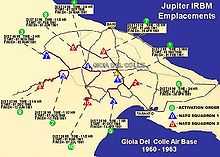
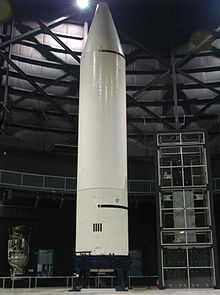
In April 1958, the U.S. Department of Defense notified the Air Force it had tentatively planned to deploy the first three Jupiter squadrons (45 missiles) in France. Negotiations between France and the U.S. fell through in June 1958. Charles De Gaulle, the new French president, refused to accept basing any Jupiter missiles in France. This prompted U.S. to explore the possibility of deploying the missiles in Italy and Turkey. The Air Force was already implementing plans to base four squadrons (60 missiles)—subsequently redefined as 20 Royal Air Force squadrons each with three missiles—of PGM-17 Thor IRBMs in Britain on airfields stretching from Yorkshire to East Anglia.
In 1958, the United States Air Force activated the 864th Strategic Missile Squadron at ABMA. Although the USAF briefly considered training its Jupiter crews at Vandenberg AFB, California, it later decided to conduct all of its training at Huntsville. In June and September of the same year the Air Force activated two more squadrons, the 865th and 866th.
In April 1959, the secretary of the Air Force issued implementing instructions to USAF to deploy two Jupiter squadrons to Italy. The two squadrons, totaling 30 missiles, were deployed at 10 sites in Italy from 1961 to 1963. They were operated by Italian Air Force crews, but USAF personnel controlled arming the nuclear warheads. The deployed missiles were under command of 36ª Aerobrigata Interdizione Strategica (36th Strategic Interdiction Air Squadron, Italian Air Force) at Gioia del Colle Air Base, Italy.
Jupiter squadrons consisted of 15 missiles and approximately 500 military personnel with five "flights" of three missiles each, manned by five officers and 10 NCOs. To reduce vulnerability, the flights were located approximately 30 miles apart, with the triple launcher emplacements separated by a distance of several hundred miles.
The ground equipment for each emplacement was housed in approximately 20 vehicles; including two generator trucks, a power distribution truck, short- and long-range theodolites, a hydraulic and pneumatic truck and a liquid oxygen truck. Another trailer carried 6000 gallons of fuel and three liquid oxygen trailers each carried 4,000 US gallons (15,000 l; 3,300 imp gal).
The missiles arrived at the emplacement on large trailers; while still on the trailer, the crew attached the hinged launch pedestal to the base of the missile which was hauled to an upright position using a winch. Once the missile was vertical, fuel and oxidizer lines were connected and the bottom third of the missile was encased in a "flower petal shelter", consisting of wedge-shaped metal panels, allowing crew members to service the missiles in all weather conditions. Stored empty, on 15-minute combat status in an upright position on the launch pad, the firing sequence included filling the fuel and oxidizer tanks with 68,000 lb (31,000 kg) of LOX and 30,000 lb (14,000 kg) of RP-1, while the guidance system was aligned and targeting information loaded. Once the fuel and oxidizer tanks were full, the launch controlling officer and two crewmen in a mobile launch control trailer could launch the missiles.
Each squadron was supported by a receipt, inspection and maintenance (RIM) area to the rear of the emplacements. RIM teams inspected new missiles and provided maintenance and repair to missiles in the field. Each RIM area also housed 25 tons of liquid oxygen and nitrogen generating plants. Several times a week, tanker trucks carried the fuel from the plant to the individual emplacements. The actual locations of the launch sites (built in a triangular configuration) were in the direct vicinities of the villages Acquaviva delle Fonti, Altamura (two sites), Gioia del Colle, Gravina in Puglia, Laterza, Mottola, Spinazzola, Irsina and Matera.
In October 1959, the location of the third and final Jupiter MRBM squadron was settled when a government-to-government agreement was signed with Turkey. The U.S. and Turkey concluded an agreement to deploy one Jupiter squadron on NATO's southern flank. One squadron totaling 15 missiles was deployed at five sites near İzmir, Turkey from 1961 to 1963, operated by USAF personnel, with the first flight of three Jupiter missiles turned over to the Türk Hava Kuvvetleri (Turkish Air Force) in late October 1962, but USAF personnel retaining control of nuclear warhead arming.
On four occasions between mid-October 1961 and August 1962, Jupiter mobile missiles carrying 1.4 megaton of TNT (5.9 PJ) nuclear warheads were struck by lightning at their bases in Italy. In each case, thermal batteries were activated, and on two occasions, tritium-deuterium "boost" gas was injected into the warhead pits, partially arming them. After the fourth lightning strike on a Jupiter MRBM, the USAF placed protective lightning strike-diversion tower arrays at all of the Italian and Turkish Jupiter MRBM missiles sites.
In 1962, a Bulgarian MiG-17 reconnaissance airplane was reported to have crashed into an olive grove near one of the U.S. Jupiter missile launch sites in Italy, after overflying the site.[2]
By the time the Turkish Jupiters had been installed, the missiles were already largely obsolete and increasingly vulnerable to Soviet attacks. All Jupiter MRBMs were removed from service by April 1963, as a backdoor trade with the Soviets in exchange for their earlier removal of MRBMs from Cuba.
Deployment sites
- United States
- Redstone Arsenal, Huntsville, Alabama 34°37′58.11″N 86°39′56.40″W / 34.6328083°N 86.6656667°W
- White Sands Missile Range, New Mexico 32°52′47.45″N 106°20′43.64″W / 32.8798472°N 106.3454556°W
- Republic of Italy
- Headquarters: Gioia del Colle Air Base
- Training Pad 40°47′6.74″N 16°55′33.5″E / 40.7852056°N 16.925972°E
- Squadron 1
- Site 1 40°44′24.59″N 16°55′58.83″E / 40.7401639°N 16.9330083°E
- Site 3 40°35′42.00″N 16°51′33.00″E / 40.5950000°N 16.8591667°E
- Site 4 40°48′47.05″N 16°22′53.08″E / 40.8130694°N 16.3814111°E
- Site 5 40°45′32.75″N 16°22′53.08″E / 40.7590972°N 16.3814111°E
- Site 7 40°57′43.98″N 16°10′54.66″E / 40.9622167°N 16.1818500°E
- Squadron 2
- Site 2 40°40′42.00″N 17°6′12.03″E / 40.6783333°N 17.1033417°E
- Site 6 40°58′6.10″N 16°30′22.73″E / 40.9683611°N 16.5063139°E
- Site 8 40°42′14.98″N 16°8′28.42″E / 40.7041611°N 16.1412278°E
- Site 9 40°55′23.40″N 16°48′28.54″E / 40.9231667°N 16.8079278°E
- Site 10 40°34′59.77″N 16°35′43.26″E / 40.5832694°N 16.5953500°E
- Turkish Republic
- Headquarters: Cigli Air Base
- Training Pad 38°31′17.32″N 27°1′3.89″E / 38.5214778°N 27.0177472°E
- Site 1 38°42′26.68″N 26°53′4.13″E / 38.7074111°N 26.8844806°E
- Site 2 38°42′23.76″N 27°53′57.66″E / 38.7066000°N 27.8993500°E
- Site 3 38°50′37.66″N 27°02′55.58″E / 38.8437944°N 27.0487722°E
- Site 4 38°44′15.13″N 27°24′51.46″E / 38.7375361°N 27.4142944°E
- Site 5 38°47′30.73″N 27°42′28.94″E / 38.7918694°N 27.7080389°E
Launch vehicle derivatives
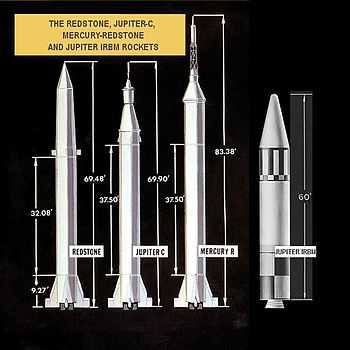
The Saturn I and Saturn IB rockets were manufactured by using a single Jupiter propellant tank, in combination with eight Redstone rocket propellant tanks clustered around it, to form a powerful first stage launch vehicle.
The Jupiter MRBM was also modified by adding upper stages, in the form of clustered Sergeant-derived rockets, to create a space launch vehicle called Juno II, not to be confused with the Juno I which was a Redstone-Jupiter-C missile development. There is also some confusion with another U.S. Army rocket called the Jupiter-C, which were Redstone missiles modified by lengthening the fuel tanks and adding small solid-fueled upper stages.
Specifications (Jupiter MRBM)
- Length: 60 ft (18.3 m)
- Diameter: 8 ft 9 in (2.67 m)
- Total Fueled Weight: 108,804 lb (49,353 kg)
- Empty Weight: 13,715 lb (6,221 kg)
- Oxygen (LOX) Weight: 68,760 lb (31,189 kg)
- RP-1 (kerosene) Weight: 30,415 lb (13,796 kg)
- Thrust: 150,000 lbf (667 kN)
- Engine: Rocketdyne LR70-NA (Model S-3D)
- ISP: 247.5 s (2.43 kN·s/kg)
- Burning time: 2 min. 37 sec.
- Propellant consumption rate: 627.7 lb/s (284.7 kg/s)
- Range: 1,500 mi (2,400 km)
- Flight time: 16 min 56.9 sec
- Cutoff velocity: 8,984 mph (14,458 km/h) – Mach 13.04
- Reentry velocity: 10,645 mph (17,131 km/h) – Mach 15.45
- Acceleration: 13.69 g (134 m/s²)
- Peak deceleration: 44.0 g (431 m/s²)
- Peak altitude: 390 mi (630 km)
- CEP 4,925 ft (1,500 m)
- Warhead: 1.45 Mt Thermonuclear W49 – 1,650 lb (750 kg)
- Fusing: Proximity and Impact
- Guidance: Inertial
Specifications (Juno II launch vehicle)

The Juno II was a four-stage rocket derived from the Jupiter IRBM. It was used for 10 satellite launches, six of which failed. It launched Pioneer 3, Pioneer 4, Explorer 7, Explorer 8, and Explorer 11.
- Juno II total length: 24.0 m
- Orbit payload to 200 km: 41 kg
- Escape velocity payload: 6 kg
- First launch date: December 6, 1958
- Last launch date: May 24, 1961
| Parameter | 1st stage | 2nd stage | 3rd stage | 4th stage |
|---|---|---|---|---|
| Gross mass | 54,431 kg | 462 kg | 126 kg | 42 kg |
| Empty mass | 5,443 kg | 231 kg | 63 kg | 21 kg |
| Thrust | 667 kN | 73 kN | 20 kN | 7 kN |
| Isp | 248 s (2.43 kN·s/kg) |
214 s (2.10 kN·s/kg) |
214 s (2.10 kN·s/kg) |
214 s (2.10 kN·s/kg) |
| Burn time | 182 s | 6 s | 6 s | 6 s |
| Length | 18.28 m | 1.0 m | 1.0 m | 1.0 m |
| Diameter | 2.67 m | 1.0 m | 0.50 m | 0.30 m |
| Engine: | Rocketdyne S-3D | Eleven Sergents | Three Sergents | One Sergent |
| Propellant | LOX/RP-1 | Solid Fuel | Solid Fuel | Solid fuel |
Jupiter MRBM and Juno II launches
There were 46 test launches, all launched from Cape Canaveral Missile Annex, Florida.[3]
- This list is incomplete; you can help by expanding it.
| Serial number | Mission | Launch date | Notes |
|---|---|---|---|
| AM-1A | AM-1A | March 1, 1957 | Test Launch 1. Missile test. Failure. Apogee 14 mi (23 km) |
| AM-1B | AM-1B | April 26, 1957 | Test Launch 2. Missile test. Failure. Apogee 18 mi (29 km) |
| AM-1 | AM-1 | May 31, 1957 | Test Launch 3. Missile test. Success. Apogee 500 mi (800 km) |
| AM-2 | AM-2 | August 28, 1957 | Test Launch 4. Missile test. Success. Apogee 500 mi (800 km) |
| AM-3 | AM-3 | October 23, 1957 | Test Launch 5. Missile test. Success. Apogee 500 mi (800 km) |
| AM-3A | AM-3A | November 27, 1957 | Test Launch 6. Missile test. Failure. Apogee 20 mi (32 km) |
| AM-4 | AM-4 | December 16, 1957 | Test Launch 7. Missile test. Failure. Apogee 63 mi (101 km) |
| AM-5 | AM-5 | May 18, 1958 | Test Launch 8. Reentry test. Success. Apogee 345 mi (555 km) |
| AM-6B | AM-6B | July 17, 1958 | Test Launch 9. Reentry test. Success. Apogee 345 mi (555 km) |
| AM-7 | AM-7 | August 27, 1958 | Test Launch 10. Missile test. Success. Apogee 345 mi (555 km) |
| AM-9 | AM-9 | October 10, 1958 | Test Launch 11. Missile test. Failure. Apogee 0 mi (0 km) |
| AM-11 | Juno II | December 6, 1958 | Launch 12. Lunar probe. Pioneer 3. Failed to reach moon. Apogee 70,610 mi (113,640 km) |
| AM-13 | Bio 1 | December 13, 1958 | Launch 13. Bio test flight. "Gordo" the monkey. Parachute failed. Apogee 345 mi (555 km) |
| CM-21 | CM-21 | January 22, 1959 | Test Launch 14. Tactical test flight. Success. Apogee 345 mi (555 km) |
| CM-22 | CM-22 | January 27, 1959 | Test Launch 15. Missile test. Success. Apogee 345 mi (555 km) |
| AM-14 | Juno II | March 3, 1959 | Launch 16. Lunar probe. Pioneer 4. Passed within 58,983 km (probably improperly converted as others were here, unless original was 36,650 mi) of moon. In solar orbit. |
| CM-22A | CM-22A | April 4, 1959 | Test Launch 17. Missile test. Success. Apogee 345 mi (555 km) |
Former operators
- 864th Strategic Missile Squadron
- 865th Strategic Missile Squadron
- 866th Strategic Missile Squadron
 Italy
Italy- Aeronautica Militare (Italian Air Force)
- 36ª Brigata Aerea Interdizione Strategica (36th Strategic Air Interdiction Brigade)
 Turkey
Turkey- Türk Hava Kuvvetleri (Turkish Air Force)
Surviving examples
The Marshall Space Flight Center in Huntsville, Alabama displays a Jupiter missile in its Rocket Garden.
The U.S. Space & Rocket Center in Huntsville, Alabama displays two Jupiters, including one in Juno II configuration, in its Rocket Park.
An SM-78/PMG-19 is on display at the Air Force Space & Missile Museum at Cape Canaveral, Florida. The missile had been present in the rocket garden for many years until 2009 when it was taken down and given a complete restoration.[4] This pristine artifact is now in sequestered storage in Hangar R on Cape Canaveral AFS and cannot be viewed by the general public.
A Jupiter (in Juno II configuration) is displayed in the Rocket Garden at Kennedy Space Center, Florida. It was damaged by Hurricane Frances in 2004,[5] but was repaired and subsequently placed back on display.
A PGM-19 is on display at the National Museum of the United States Air Force in Dayton, Ohio. The missile was obtained from the Chrysler Corporation in 1963. For decades it was displayed outside the museum, before being removed in 1998. The missile was restored by the museum's staff and was returned to display in the museum's new Missile Silo Gallery in 2007.[6]
A PGM-19 is on display at the South Carolina State Fairgrounds in Columbia, South Carolina. The missile, named Columbia, was presented to the city in the early 1960s by the US Air Force. It was installed at the fairgrounds in 1969 at a cost of $10,000.[7]
Air Power Park in Hampton, Virginia displays an SM-78.
The Virginia Museum of Transportation in downtown Roanoke, Virginia displays a Jupiter PGM-19.
See also
- List of United States Air Force missile squadrons
- List of missiles
- M-numbers
- Strategic Air Command
- Theatre ballistic missiles
References
- ↑ Parsch, Andreas. "Jupiter". Encyclopedia Astronautica. Retrieved 26 April 2014.
- ↑ Lednicer, David (9 December 2010). "Intrusions, Overflights, Shootdowns and Defections During the Cold War and Thereafter". Aviation History Pages. Retrieved 16 January 2011.
- ↑ Wade, Mark. "Juno II". Encyclopedia Astronautica. Retrieved 16 January 2011.
- ↑ "Jupiter". Cape Canaveral, Florida: Air Force Space and Missile Museum. Retrieved 26 April 2014.
- ↑ "Hurricane Frances damage to Kennedy Space Center". collect SPACE. Retrieved 24 February 2012.
- ↑ "Factsheets : Chrysler SM-78/PGM-19A Jupiter". National Museum of the United States Air Force. Retrieved 26 April 2014.
- ↑ Rantin, Bertram (6 October 2010). "The 2010 SC State Fair is just a week away". The State (South Carolina). Archived from the original on 7 October 2010. Retrieved 26 April 2014.
External links
| Wikimedia Commons has media related to Jupiter (missile). |
- Jupiter IRBM History, U.S. Army – Redstone Arsenal
- Jupiter IRBM, Encyclopedia Astronautica
- The Jupiter Missiles of Turkey, G. L. Smith
- Detailed spherical panoramas inside the aft (engine) compartment
| ||||||||||||||||||||||||
| ||||||||||||||||||||||||||||||||||||||||||||||||||||||||||||||||||
| ||||||||||||||||||||||
